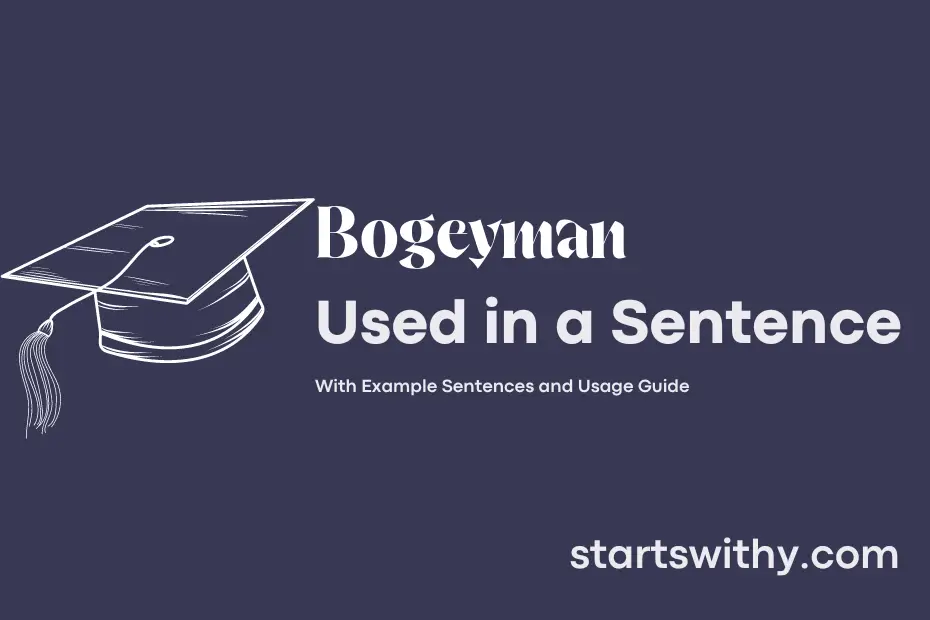Are you familiar with the term “bogeyman”? This mythical creature is often used as a cautionary figure in folklore to scare children into good behavior. The bogeyman is portrayed as a sinister being who preys on those who misbehave.
In literature and popular culture, the bogeyman is a common motif that represents fear and consequences for disobedience. This character is typically depicted as a dark and looming figure, serving as a warning to individuals, especially children, to follow rules and avoid trouble.
7 Examples Of Bogeyman Used In a Sentence For Kids
- The bogeyman hides under the bed and in the closet.
- Don’t be afraid of the bogeyman, he’s not real.
- The bogeyman only comes out at night when you’re asleep.
- Remember, the bogeyman is just a make-believe story.
- If you’re scared, just ask Mom or Dad to check for the bogeyman.
- The bogeyman doesn’t like it when you’re brave and strong.
- Giggle and laugh to scare away the bogeyman!
14 Sentences with Bogeyman Examples
- Have you heard the urban legend about the bogeyman haunting the old library at midnight?
- Some students avoid studying in the deserted classroom at night, fearing the bogeyman might be lurking around.
- Most college students love sharing spooky stories about the bogeyman during hostel sleepovers.
- After watching a horror movie, a group of friends joked about summoning the bogeyman.
- One student claimed to have seen the bogeyman while walking through the dark alley near the campus.
- The annual college Halloween party featured a haunted house with decorations of the bogeyman.
- During exam season, many students feel like the bogeyman is constantly breathing down their necks.
- A daring group of friends decided to explore the abandoned building where the bogeyman was said to reside.
- The local superstition warned against venturing into the forest at night, for fear of encountering the bogeyman.
- A professor warned his students not to believe in mythological creatures like the bogeyman.
- The college folklore club held a meeting to discuss the various interpretations of the bogeyman across different cultures.
- Campus security increased patrols after rumors of the bogeyman spread among the students.
- A student’s night terror about the bogeyman caused them to wake up screaming in the middle of the night.
- The college magazine published an article exploring the psychology behind the fear of the bogeyman.
How To Use Bogeyman in Sentences?
Bogeyman
To use the word Bogeyman in a sentence, start by identifying a situation where someone or something is causing fear or anxiety. Then, insert Bogeyman to refer to an imaginary evil figure people dread. For example, “Don’t let the Bogeyman of failure prevent you from taking risks and pursuing your dreams.”
Remember that Bogeyman is often used metaphorically to describe a perceived threat that is intangible or exaggerated. It can refer to a person, an idea, or a situation that creates fear and acts as a barrier to progress. For instance, “The Bogeyman of uncertainty loomed over the decision-making process, making it difficult for the team to move forward.”
Additionally, Bogeyman can symbolize the unknown or unseen dangers that people imagine to be lurking around them. By incorporating it into your writing or speech, you can paint a vivid picture of fear or apprehension. For instance, “The political candidate used the Bogeyman of economic collapse to rally supporters and sway public opinion.”
In conclusion, using the word Bogeyman can add depth and emotion to your communication by tapping into universal fears and anxieties. Experiment with different contexts and scenarios to master the art of incorporating Bogeyman effectively in your sentences.
Conclusion
In conclusion, the bogeyman is a prominent figure in various cultures and stories, often used to instill fear in children. The idea of the bogeyman is utilized as a cautionary tale, warning children of potential dangers and consequences. While the specifics of the bogeyman may vary across different cultures, the common thread is the portrayal of a sinister figure lurking in the shadows.
Overall, the concept of the bogeyman serves as a reminder of the importance of caution and vigilance, especially for the vulnerable and impressionable. Whether portrayed as a monstrous creature or a faceless threat, the bogeyman remains a powerful symbol in storytelling, reinforcing lessons about safety and the consequences of misbehavior.



